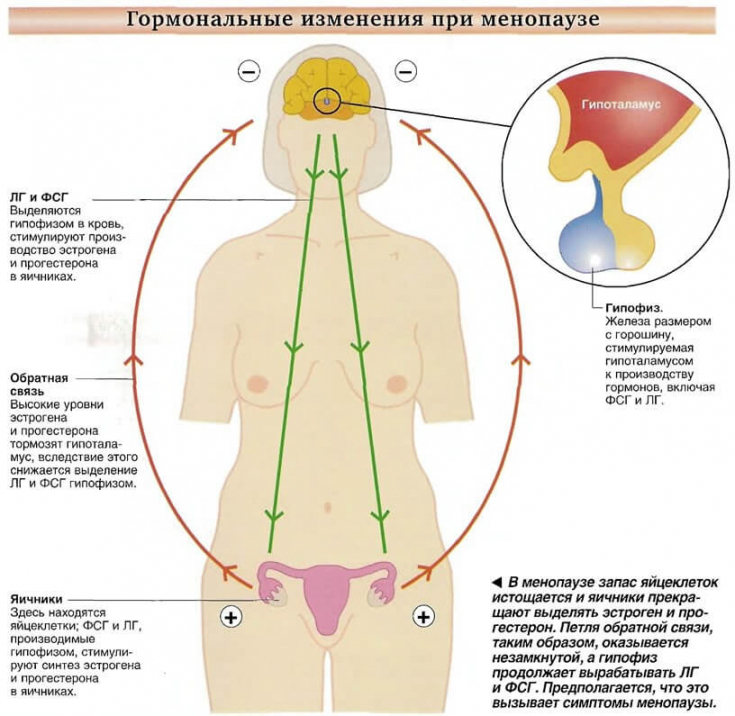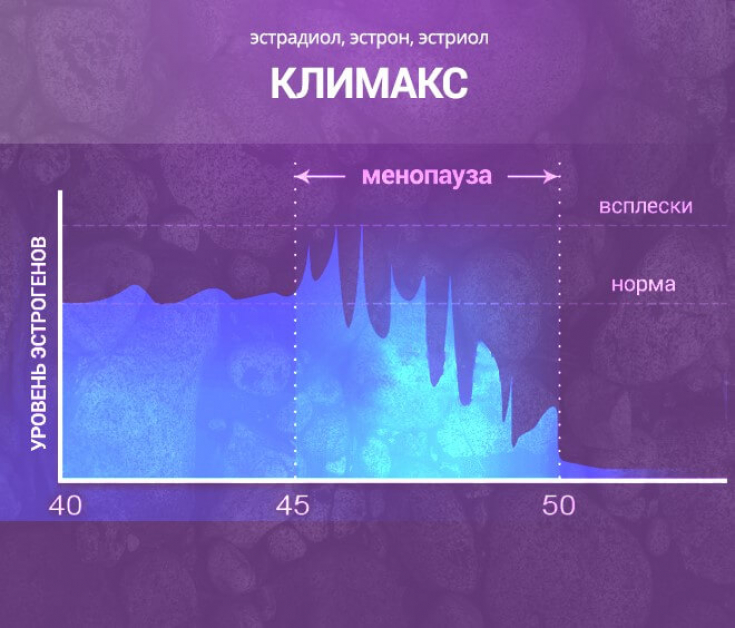Menopause is the result of a decrease and a change in hormone levels. There are four main hormones that are involved in the regulation of the menstrual cycle, these are:
- estrogen;
- progesterone;
- luteinizing hormone;
- follicle stimulating hormone.
The last two hormones are involved in negative feedback pathways to regulate estrogen, progesterone and testosterone levels.
Skin changes that begin to appear during the perimenopausal period are mainly associated with decreased estrogen levels, but other sex hormones also play a role in the aging process.
At estet-portal.com we will look at the effect of hormone levels on skin during menopause.
- Estrogen and skin aging during menopause
- Decrease in estrogen levels leads to dry skin
- Skin atrophy: when there is not enough female hormones
- Skin pigmentation: how estrogen affects melanocytes
Estrogen and skin aging during menopause
Estrogen is responsible for regulating the menstrual cycle, thickening of the endometrium, and the development of female secondary sexual characteristics such as breast development.
Menopause is an example of intrinsic aging. This is aging that occurs as a result of physiological changes (mainly due to a decrease in estrogen secretion) that occur over a period of time.
Skin aging is manifested by atrophy of the epidermis, dermis and subcutaneous fat.
It has been found that collagen levels can decrease by up to 30% in the first five years after menopause.
Within the epidermis aging results in:
- reducing the thickness of the epidermis;
- flattening of dermal papillae;
- decrease in the density of melanocytes and Langerhans cells.

The aging of the dermis is accompanied by a decrease in fibroblast activity and a decrease in the content of collagen and hyaluronic acid.
In combination with fragmentation of the elastin fiber and reduced blood flow, this affects dermal atrophy and the rate of cell renewalk.
Estrogens on the alert: female sex hormones against aging
Decrease in estrogen levels leads to dry skin
Estrogen plays a role in the growth and repair of the dermal capillaries that nourish the skin, including the epidermal basal layers and the stratum germinativum, also known as the stratum basalis.
The decrease in estrogen caused by menopause results in a decrease in adequate blood supply to the skin and this results in a slower rate of cell turnover. Epidermal barrier function is compromised due to slow cellular turnover and increased transepidermal water loss.
While a woman's skin is likely to become drier during menopause, changes in estrogen levels can cause acne.

With the decrease in estrogen levels during menopause, testosterone levels rise as a result of insufficient estrogen inhibition. Testosterone stimulates the sebaceous glands, which produce thicker sebum, which can lead to acneth.
Read the latest articles in Telegram!
Skin atrophy: when there is not enough female hormones
Skin atrophy is another consequence of declining estrogen levels.
Skin thickness decreases by 1.13% per year after menopause. Along with this, the loss of collagen is 2% per year.
Estrogens play an important role in the synthesis of collagen and elastin.
Consequently, reduced estrogen production affects the formation and repair of collagen and elastin in the dermis of the skin, resulting in thinning of the skin and loss of elasticity.
Another role of estrogen is to stimulate the deposition of fat evenly throughout the body. During menopause, body fat is redistributed, resulting in hypotrophy of facial fat packages. The skin becomes flabby, undergoes ptosisy.
Reproductive system hormones: progesterone, estradiol, testosterone
Skin pigmentation: how estrogen affects melanocytes
Estrogen plays an important role in the regulation of skin pigmentation, along with a host of other hormones. It does this by maintaining the structure and function of melanocytes, and is also involved in the regulation of melanin secretion.
As melanocytes decrease, melanin production decreases, skin becomes lighter and more vulnerable to UV damage. This highlights the importance of using sunscreen especially after menopause.
After a decrease in estrogen levels, the remaining unregulated melanocytes can produce melanin at an uncontrolled rate and distribution, such that it appears on the skin as age spots and small areas of hyperpigmentation.







Add a comment